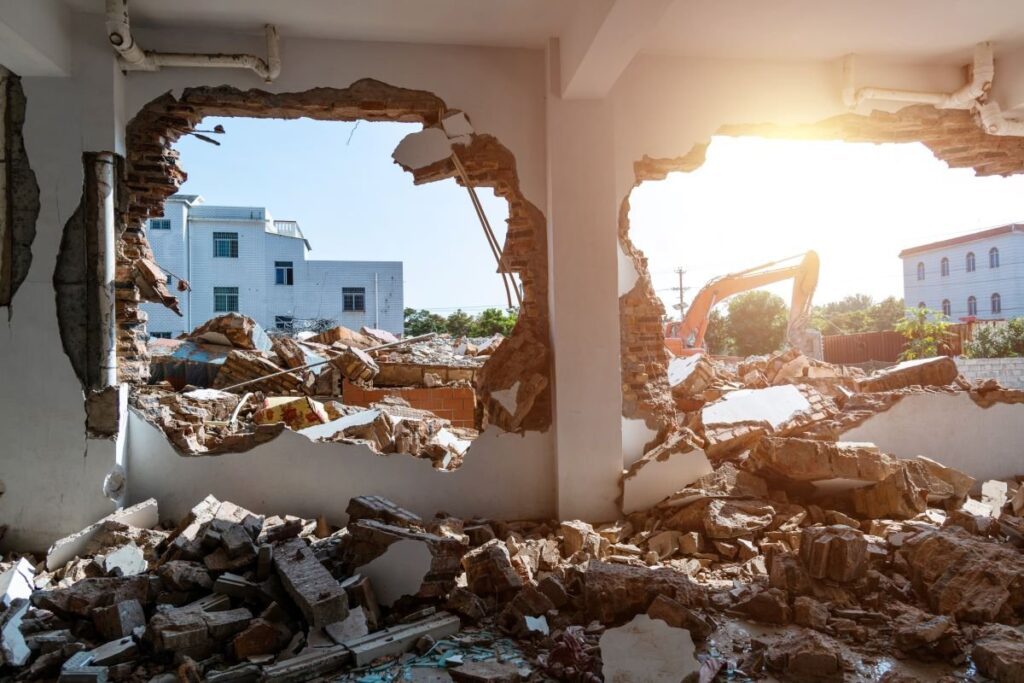Are you considering demolishing an old building to make way for the home of your dreams? Do you want to get rid of an outdated structure on your property to install a swimming pool?
Leveling, undermining, and demolition by cutting—demolition methods can vary significantly depending on the scope and type of project.
Discover the various demolition methods and the criteria on which project owners base their choices.
Criteria to Consider When Choosing a Demolition Method
Regardless of your reasons for wanting to partially or completely demolish a building, you need to hire a demolition company. Only professionals in the field can adequately advise you on the most suitable demolition method for your project.
To decide on the best course of action, the project owner will consider the following factors:
- The location of the building to be demolished (indoor or outdoor).
- The building height.
- Its structure and shape (industrial buildings, apartment buildings, houses).
- The materials it is made of (concrete, reinforced concrete, metal structures).
- Whether or not it has a framework.
- The environment (demolition of a semi-detached house, possible constraints related to noise, vibrations, or dust).
Contact Our Demolition Experts
Once these criteria are considered, the project owner can choose the most suitable method for your project from the following:
- Manual demolition: leveling or undermining.
- Mechanical demolition: bucket and hook method with a demolition excavator, bulldozer method, or demolition shear method.
- Demolition by cutting.
- Explosive demolition.
- Expansion demolition.
Leveling
The “leveling” demolition method is a manual operation that involves destroying a structure by first knocking down the highest parts of the building. This technique is primarily used to reduce the height of a structure without altering the foundations (for example, for partial restoration).
Leveling is also the ideal method to demolish a building while protecting nearby homes from potential falling debris.
Leveling is mainly used for the following projects:
- Restoration of a church bell tower.
- Demolition of walls and fortifications.
- Demolition of a tower.
Undermining
Unlike leveling, undermining involves demolishing a structure from the bottom up. Demolition professionals “undermine the base,” meaning they destroy the building’s foundations by creating a trench. Then they proceed by placing wedges and props on the load-bearing parts to replace those that were demolished.
Once this work is completed, the wedges and props are destroyed (or burned if they are wooden) so the entire structure collapses.
Undermining is mainly used to demolish a turret or a chimney. However, this technique is not recommended when there are homes nearby.
Bulldozer Method
Bulldozers are perfect for demolishing buildings made of cinder blocks or bricks. These machines (also called dozers) are equipped with a blade that pushes materials to make them fall. The main advantage of the bulldozer technique is that it allows debris to be directly loaded into the bin, facilitating waste management on the site.
However, this technique is only applicable to buildings less than 3 meters high. This measure must be strictly observed to avoid deadly projections.
Bucket and Hook Method
This demolition technique requires a hydraulic mechanical excavator. With this machine, the structure demolition can be done by pushing (applying pressure to the building), pulling (pulling on the building), or striking (hitting the structure to shake the foundations).
The bucket excavator is generally used to destroy low structures that do not resist traction much. It is the ideal tool for demolishing load-bearing walls and buildings made of cinder blocks or bricks.
As for the hook excavator, it is mainly used for secondary demolitions. In this case, the clamp is used to break blocks that have fallen to the ground or to separate metal from concrete.
Demolition Shear Method
Attached to the jaw of a mechanical excavator, the demolition shear allows concrete parts to be crushed. This machine is often used to destroy concrete or steel structures, cut steel profiles, or crush and divide materials.
Demolition by Cutting
Demolition by cutting is a method that generates neither shock nor vibration. It is used to map out precisely the parts to be demolished. Cutting can be done by hydro-demolition (projecting a high-pressure water jet), sawing, or using a diamond tool.
Explosive Demolition
Explosive demolition is the safest and most economical way to demolish a building over 20 meters high. However, this method requires great technical expertise and a thorough knowledge of structures, regardless of the materials used.
Depending on the building structure, the type of charge and the explosion method may vary.
Expansion Demolition
Expansion demolition is the recommended solution for partial demolition. It is based on the principle of spreading or dislocating.
This type of demolition can be done using hydraulic spreaders, hydraulic jacks, or expansive agents. The main advantage of expansion demolition is that it offers a solution that generates neither dust nor vibrations.
Want to Undertake Demolition Work? Contact Excavation Chanthier
As you have read throughout this article, demolishing a building is a process that requires careful planning and execution. Each method has advantages and disadvantages that should be considered before starting a demolition project.
Do you live in Greater Montreal and want to take on demolition work?
At Excavation Chanthier, all our demolition interventions are carefully planned and executed. Whether it’s a residential demolition, garage demolition, or post-disaster demolition, we guarantee our clients professional and fast service.
To discuss your demolition project with experts in the field, feel free to contact our team.


